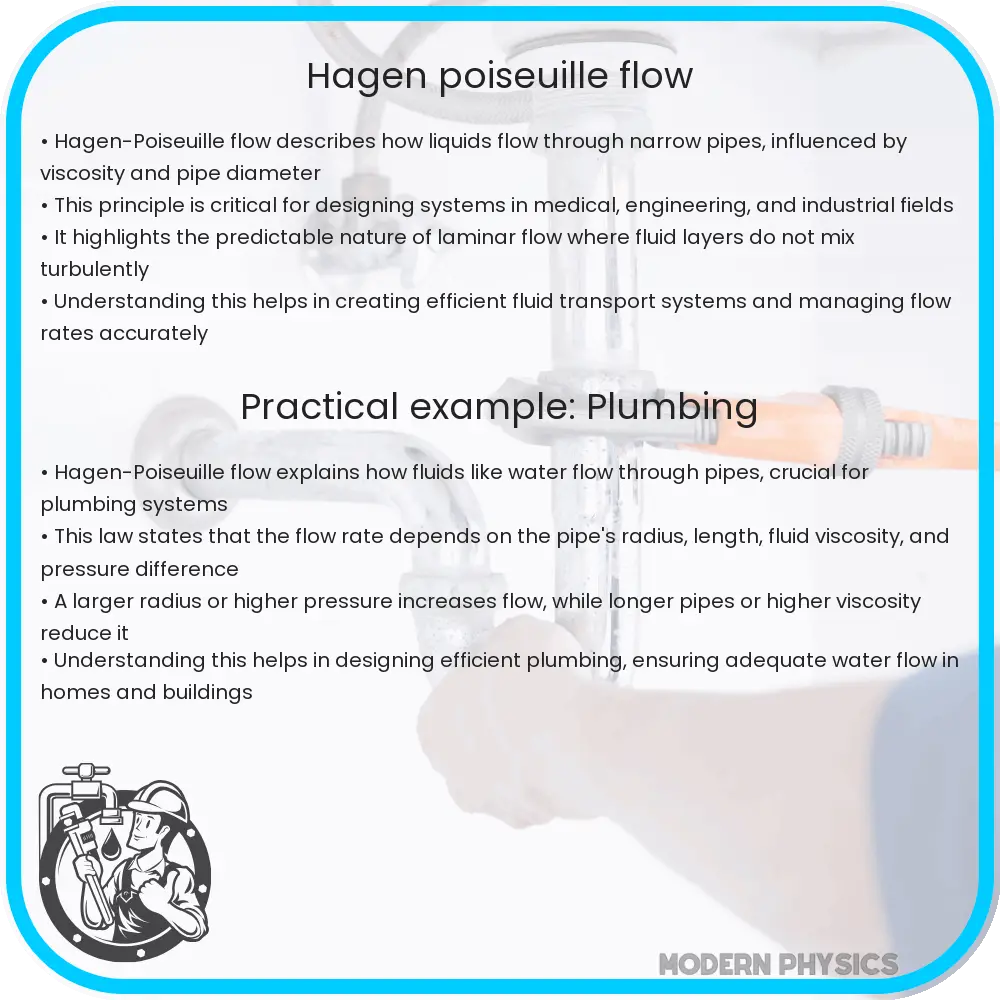Explore the principles and applications of Hagen-Poiseuille flow in chemical engineering, from basic concepts to advanced fluid dynamics analysis.

Understanding Hagen-Poiseuille Flow
The Hagen-Poiseuille flow, named after Gotthilf Hagen and Jean Léonard Marie Poiseuille, is a fundamental concept in fluid dynamics, particularly significant in the field of chemical engineering. This principle describes the flow of incompressible, viscous fluids through a long, circular pipe. It is a quintessential example of laminar flow, where fluid particles move in parallel layers, with no disruption between them.
Principles of Hagen-Poiseuille Flow
At the core of Hagen-Poiseuille flow is the balance between pressure force and viscous drag. The pressure difference between two ends of the pipe drives the fluid, while the viscosity of the fluid provides resistance. The flow rate (Q) can be calculated using the formula:
\[ Q = \frac{\pi \Delta P r^{4}}{8 \mu l} \]
where \(\Delta P\) is the pressure difference, \(r\) is the radius of the pipe, \(\mu\) is the dynamic viscosity of the fluid, and \(l\) is the length of the pipe.
Applications in Chemical Engineering
Hagen-Poiseuille flow finds extensive applications in chemical engineering, particularly in the design of piping systems for transporting liquids. Engineers use this principle to calculate the required pump pressure, determine the size of the pipes, and understand the behavior of fluids in various conditions. It’s also crucial in the design of microfluidic devices, where precise control of fluid flow is necessary.
- Pharmaceutical Industry: In the manufacturing of medicines, where precise dosages of liquid components are required.
- Petroleum Engineering: Understanding the flow of oil through pipelines.
- Food Processing: In designing equipment for handling viscous fluids like syrups or creams.
Analysis and Relevance
The analysis of Hagen-Poiseuille flow is vital in understanding real-world fluid dynamics. While ideal conditions (like laminar flow and incompressibility) are assumed in the Hagen-Poiseuille equation, engineers often use this as a starting point and then adjust for real-world factors like turbulence and temperature changes. This analysis helps in predicting the behavior of fluids in various industrial processes, ensuring efficiency and safety in operations.
Despite its simplicity, the Hagen-Poiseuille equation is a powerful tool in chemical engineering. Its ability to predict fluid behavior under different conditions makes it indispensable for engineers and researchers in the field.
Advanced Analysis of Hagen-Poiseuille Flow
Delving deeper into Hagen-Poiseuille flow, advanced analyses consider factors like non-Newtonian fluids, which exhibit different viscosities depending on the shear rate. This consideration is crucial in industries dealing with complex liquids like polymers or slurries. Additionally, in situations involving pulsatile flow, such as in biomedical applications, the Hagen-Poiseuille model is modified to accommodate oscillatory components.
Limitations and Real-world Adjustments
While the Hagen-Poiseuille equation provides a solid foundation, it has limitations. Real-world applications often involve turbulent flow, non-circular pipes, or non-uniform fluid properties. Engineers typically employ computational fluid dynamics (CFD) simulations to model these more complex scenarios, incorporating factors like pipe roughness, flow instabilities, and temperature-dependent viscosity.
Recent Advances and Future Prospects
Recent technological advances have expanded the application of Hagen-Poiseuille flow principles. Microfluidics, a field dealing with fluid flows at the microscale, heavily relies on these principles. Innovations in this area have led to the development of lab-on-a-chip devices, which are revolutionizing medical diagnostics and biochemical analysis.
In the future, the principles of Hagen-Poiseuille flow are expected to contribute significantly to the development of nano-scale fluid systems, offering potential breakthroughs in various fields like drug delivery and molecular biology.
Conclusion
The Hagen-Poiseuille flow, with its fundamental principles of fluid dynamics, continues to be a cornerstone in the field of chemical engineering. Its relevance extends beyond traditional applications, paving the way for innovation in areas like microfluidics and nanotechnology. Understanding and applying the Hagen-Poiseuille equation enables engineers and scientists to design efficient systems for fluid transport and manipulation, crucial in a wide range of industrial and scientific applications. Despite its limitations, the principle remains a vital tool, guiding future advancements and ensuring continual improvements in fluid handling and analysis. In conclusion, the enduring significance of Hagen-Poiseuille flow lies in its simplicity and adaptability, making it an indispensable part of modern engineering and scientific research.
